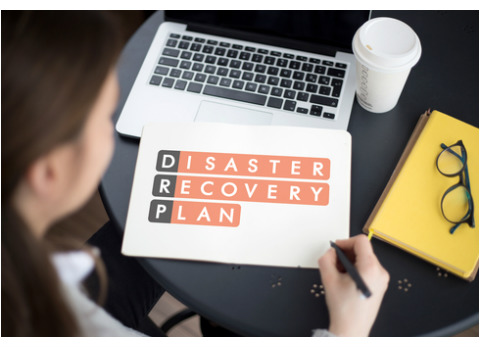No matter what your business is, you want guaranteed business continuity. Here are six ways a solid disaster recovery plan will benefit your business.
For businesses in today’s economy, one main focus of operations management is to ensure business continuity. One of the most important tools to achieve this goal is to make sure your company has an effective disaster recovery plan or DRP.
The DRP is a structured document with detailed instructions on how the company will respond to unplanned incidents that may risk the company’s operations. In addition to a solid course in business continuity and disaster recovery, read on to learn more about the importance of having a disaster recovery plan in business:
1. You’ll save money and resources if a disaster occurs.
The main benefit of having your own disaster recovery plan is the long-term cost savings. A well-planned DRP in place will ensure that your company can minimize the potential lost revenue and customers in the event of a disaster. Downtime and shutdown during disasters can also affect your investors, customers, and suppliers. A properly executed DRP guarantees that your company will recover quickly and more smoothly from a shutdown.
2. You’ll be able to recover your data and important information.
Part of a disaster recovery plan is for your company to have mobile apps that will automatically backup databases in your computers and smartphones. Still, many companies fail to have any safety measures for employee phones or computers.
It is critical that key employees of any company have a way to recall their contacts and sensitive information if ever an IT crash happens during a disaster. These days, companies like Backup-Pal and FutureDial Inc. have designed mobile backup and recovery systems that can be installed on every employee phone.
Besides mobile data backup systems, you’ll also want to an efficient way to instantly notify all of your employees about a disaster or emergency. To that end, it also pays to invest in a mobile mass alerts provider. Be sure to check out our recent stories on emergency alerts.
3. Your company will limit its losses.
A major concern both for manufacturing operations and information systems, downtime of operations can mean a lot of losses. These aren’t limited to just lost revenues, but also to possible damage to equipment and infrastructure. These potential damages may also lead to costs being incurred for repair and technical assistance in order for your company to return to normal operations.
4. A disaster recovery plan protects your company reputation.
 Downtimes and delay in delivery times may mean the end of a good run in terms of reliable operations. Delays in operations can severely damage a company’s name and reputation, and these will be remembered by affected customers for a long time. Damage to the corporate image can be irreversible, and may mean the loss of major clients in very competitive markets.
Downtimes and delay in delivery times may mean the end of a good run in terms of reliable operations. Delays in operations can severely damage a company’s name and reputation, and these will be remembered by affected customers for a long time. Damage to the corporate image can be irreversible, and may mean the loss of major clients in very competitive markets.
Having a reliable DRP in place will ensure that downtimes will be minimized and will be managed, especially on the client’s side in order to prevent damage to the company’s reputation.
5. In spite of a disaster, you can improve customer retention.
One major value that clients give importance to is reliability. Failures and downtimes can mean lots of losses down the line, which will greatly affect the client’s own operations and profit. Not meeting the client’s expectations and demands may force them to transfer to another service provider. Once these customers move on to competing service providers, it would be an almost impossible task to win them back in the aftermath of a mismanaged disaster.
With the help of a clearly-written DRP, your company can manage a negative situation effectively without sacrificing the service you give to your clients. In fact, you add to your reputation as a stable company if your clients witness how you surpass a disaster and triumph in spite of that setback.
6. You’ll increase employee productivity.
Assignment and allocation of roles during a disaster may prove to be a challenging and stressful task, when done under pressure. A properly-designed DRP will have all the responsible personnel defined for each critical task—each with their own backup and assisting roles clearly designated. When all the roles and tasks are defined in advance, productivity and morale will increase. Moreover, conflicts will be minimized during crisis times.
Redundancy is critical for disaster recovery planning, not just for equipment but also for assigned personnel. Multiple people assigned for the same tasks will ensure that at least one will be present when a disaster strikes, as some may be out due to sickness, vacations, or otherwise involved in other tasks.
This will also protect the company in the event an employee leaves, as they won’t have empty positions with critical responsibilities. Having backups and assisting roles will give management the peace of mind that they can react to and solve any incident that may arise.
Conclusion
A solid disaster recovery plan is only as effective as the people who will carry it out. That means it’s worthwhile for your employees to be involved in the planning stages of the DRP, so that they fully understand how critical their roles are when needed. Prior knowledge of those required tasks will ensure smooth execution when disaster strikes, and that will lead to your company’s fast recovery.
If you’re a company owner, sending one of your trusted employees to study business continuity and disaster recovery at UAB, the University of Alabama at Birmingham, is one of the wisest investments you can make to protect your business. Their program is highly regarded and affordable, so check them out now.
This story’s trending topics: business continuity planning, business disaster planning, company disaster preparedness, disaster recovery plan tips, DRP strategies





